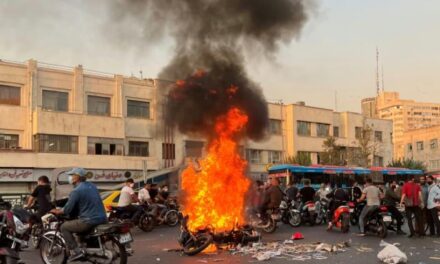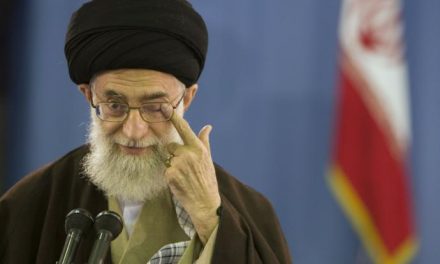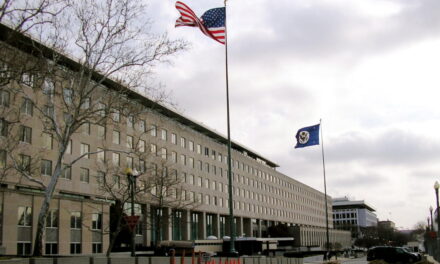Nuclear warmongering not seen since Barry Goldwater in 1964! Back to the future of oblivion? Clock is set one minute to midnight.
Sen Tom Cotton on Russian military strategy CSIS VIDEO - July 17, 2017
Senator Tom Cotton on Russian Military Strategy in Europe Republican Senator Tom Cotton (R-AR) delivered keynote remarks at a discussion on Russia’s military strategy in Europe and their violation of the 1987 Intermediate-Range Nuclear Forces (INF) Treaty after reports surfaced that Russia recently tested weapons prohibited under the treaty. Senator Cotton, who chairs the Senate Armed Services AirLand subcommittee, said there could be no re-negotiation of the current treaty because of Russia’s violation and urged the U.S. to continue to put pressure on Russia. He added that Russia was capable of hitting the U.S. and that the nation was trying to divide the West as it did in the 1980s.
Andrew Hunter CSIS director Defense-Industrial Initiative Group
The Best Data Visualizations from CSIS
CSIS is one of the world’s preeminent international policy institutions focused on defense and security, regional study, and transnational challenges ranging from energy and trade to global development and economic integration. The Andreas C. Dracopoulos iDeas Lab enhances CSIS’s research through the latest in cutting-edge web technologies, design, and video. iDeas Lab visualizations bring our data to life. Take a look at some of our best data visualizations, and learn more about the iDeas Lab here.
The Missile Threat from Russia – NATO A2AD Environment
Among the concerns of the NATO alliance in the post-Crimea era is the increase in Russia’s anti-access area denial (A2AD) capabilities. A2AD forces are classified as those that contribute to denying an adversary’s forces access to a particular region or otherwise hinder freedom of maneuver. A2AD forces typically include air defenses, counter-maritime forces, and theater offensive strike weapons, such as short- or medium-range ballistic missiles, cruise missiles, and other precision guided munitions.
Russia has invested considerable energy into developing A2AD capabilities and carefully positioning them to maximize their strategic effect. Russia’s A2AD deployments span as far north as the Arctic down to Syria, with particular concentrations in Kaliningrad and around Crimea – a sort of “thicket of overlapping and redundant A2/AD systems.”1 In the event of a crisis, such deployments would complicate NATO’s ability to access key areas such as the Baltics or Poland. These relative weaknesses within NATO could increase the attractiveness to Russia of a fait-accompli.
Remember Barack Obama bull$hitting the global community … placing anti-missile systems in “New Europe” because of the ICBM threat from … Iran!
Continued below the fold …
From my recent diary …
U.S. Congress: Preparing for a Global Armed Conflict …
Senator Cotton, who chairs the Senate Armed Services AirLand subcommittee, said there could be no re-negotiation of the current treaty because of Russia’s violation and urged the U.S. to continue to put pressure on Russia. He added that Russia was capable of hitting the U.S. and that the nation was trying to divide the West as it did in the 1980s.
… facilitate the transfer of cruise-missile technology to our allies. As I’ve noted, only the United States and Russia signed this treaty; no other country did. So even if we can’t build intermediate missiles, that doesn’t mean our allies cannot. And it also doesn’t mean we cannot help them. For instance, the Polish government has been acquiring air-launched cruise missiles for some time. I suspect Warsaw might be interested in ground-launched cruise missiles as well, which I further suspect might make the Kremlin less keen on ripping up the INF Treaty.
Finally, we would present Russia with a very simple choice: either you observe the INF Treaty, or we won’t renew our commitments to other treaties. Specifically, the legislation would prohibit further funding for two treaties that Russia wants to preserve. The first is an extension of the New START Treaty, which imposes greater limits on our strategic nuclear forces than on Russia’s. The second is the Open Skies Treaty, which Russia needs more for overhead imagery intelligence than we do. If the Russians won’t keep their INF commitments, why should the United States continue other treaties that benefit them?
A good read, the Yeltsin – Putin transition:
○ The Russian Roller Coaster | WPJ Winter 2003/04 | by Ian Bremmer
We’ve got to fix the belligerence of Russia’s Putin first, planet Earth comes later!
ADDENDUM:
NATO-Russia Relations in a Post-Truth World | Carnegie – Europe |
The so-called post-truth era was a fundamental element in shaping international relations in 2016. There is no doubt that Russia actively helped spread a malicious post-truth worm to put the world out of kilter. Through its actions, Moscow targeted multiple institutions, organizations, and countries.
Russia also made an extraordinary effort to undermine the coherence, unity, and indivisibility of NATO. Moscow accused the alliance of being unable to adapt to an emerging new world order. In fact, Russian actions were aimed at holding NATO-Russia relations hostage in a post-truth world. Unexpectedly, at the beginning of 2017, the Russian Foreign Ministry spoke out in favor of a reset with NATO. Yet the Kremlin’s maneuvers in previous months suggest this may be just another post-truth ruse.
In July 2016, despite Russia’s ongoing aggression against Ukraine and bombing of Syria, NATO decided at its summit in Warsaw to put a genuine offer of dialogue with Russia on the table. NATO’s approach would be geared toward “periodic, focused and meaningful dialogue . . . on the basis of reciprocity.” The alliance’s goals were clear: to discuss the Russia-Ukraine conflict; to avoid misunderstanding, miscalculation, and unintended escalation; and to increase transparency and predictability. Most importantly, as stated in the summit communiqué, this dialogue was aimed at “a Russia willing to engage.”
A NATO-Russia Council meeting was convened on July 13, 2016, just four days after the summit. The alliance presented a briefing on the outcomes of the summit, a move that–based on the principles outlined by NATO–Russia should have reciprocated. To increase transparency in mutual relations, NATO would welcome a briefing on developments such as Russia’s decision to create three new military divisions in its Western Military District. At the same time, allies continued to suggest concrete options to enhance predictability and transparency in the Euro-Atlantic area.
After six months, it is clear that Russia, by contrast, has chosen a path of confrontation. The NATO-Russia Council meeting on December 19, 2016, proved that the West is still waiting for a Russia willing to engage. The Russian Foreign Policy Concept approved on November 30, 2016, shows how Moscow’s priorities pivoted from the economy to security and defense. And Russia’s actions in the last half year demonstrate that Moscow continues to treat the West like a rival in a zero-sum game.








